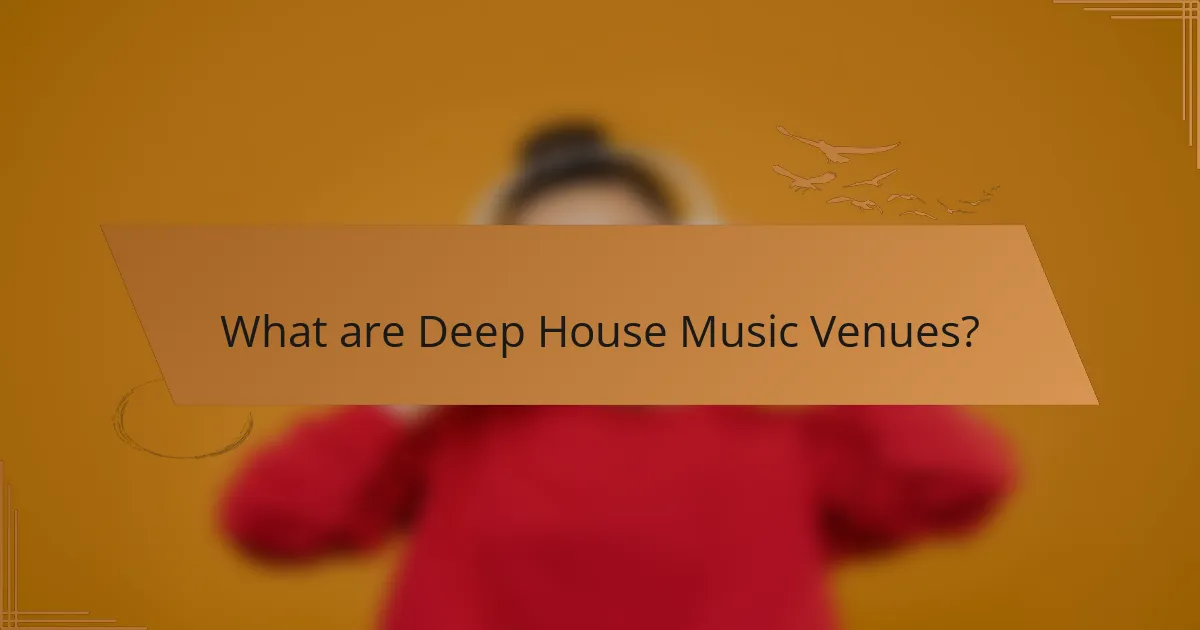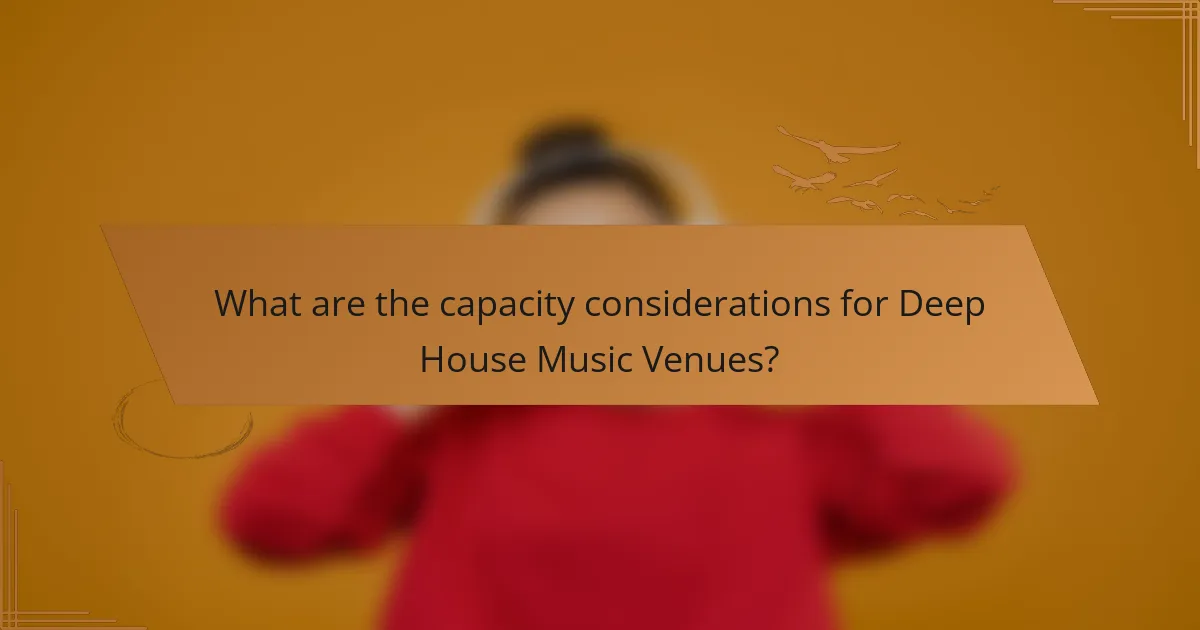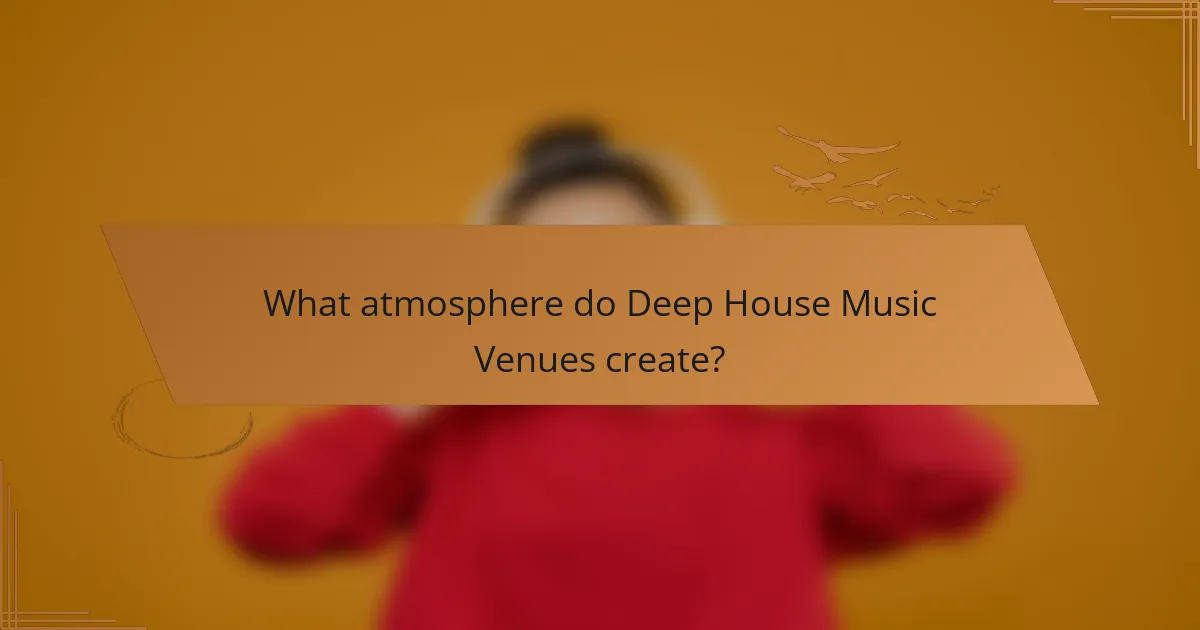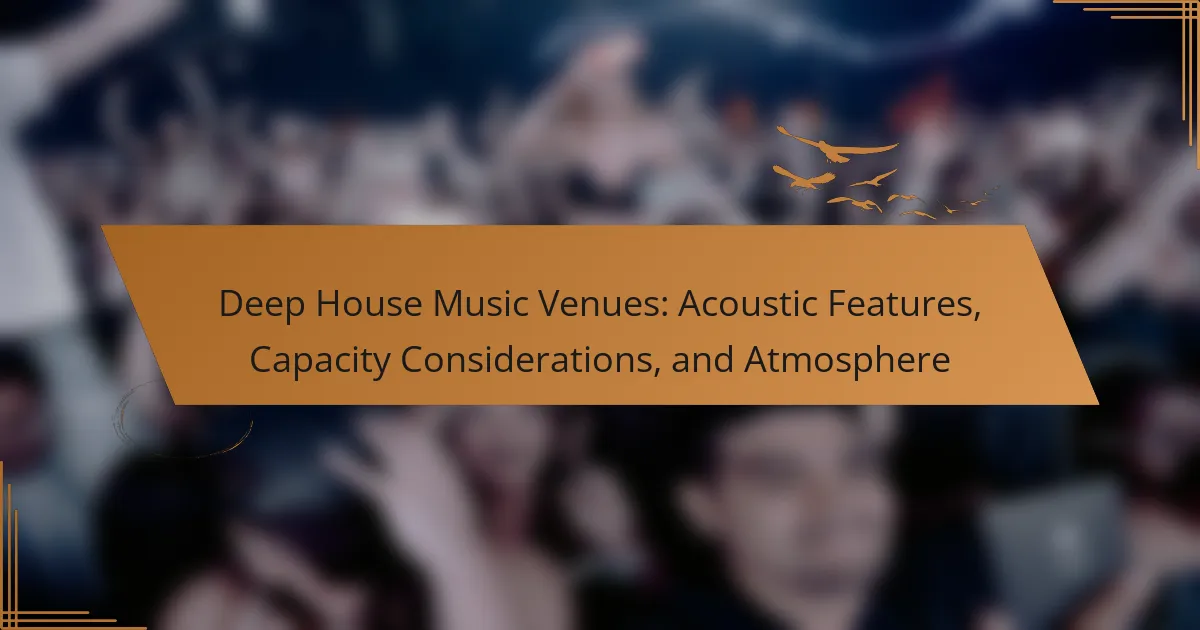Deep house music venues are specialized spaces designed for hosting deep house music events, characterized by high-quality sound systems and a variety of seating arrangements. These venues create an intimate atmosphere enhanced by thoughtful lighting and visual art, fostering a sense of community among attendees. Capacity considerations are crucial, as they impact audience comfort and sound quality; venues typically accommodate between 200 to 1,000 attendees based on design and layout. The overall experience is enriched by the venue’s acoustic features and social interaction opportunities, making them ideal for deep house music lovers.

What are Deep House Music Venues?
Deep house music venues are spaces specifically designed for hosting deep house music events. These venues often feature high-quality sound systems to enhance the acoustic experience. They typically have a dance floor where attendees can enjoy the music. Many deep house venues also include lounges or seating areas for socializing.
The atmosphere in these venues is usually intimate and relaxed. Lighting plays a significant role in creating the right ambiance. Some venues may also incorporate visual art or projections to enhance the experience. Popular deep house venues can be found in urban areas known for nightlife. Examples include clubs, bars, or dedicated music halls.
How do Deep House Music Venues differ from other music venues?
Deep house music venues differ from other music venues primarily in their acoustic design and atmosphere. These venues often feature sound systems optimized for deep bass and intricate soundscapes. The layout is typically intimate, encouraging close interaction between the audience and performers.
Lighting in deep house venues is often subdued and atmospheric, enhancing the immersive experience. Many deep house venues focus on creating a lounge-like environment, contrasting with the more energetic setups of other genres.
Capacity is usually smaller, allowing for a more personal experience. This setting fosters a sense of community among attendees, which is a hallmark of deep house culture. The overall ambiance is designed to promote relaxation and prolonged enjoyment of the music.
What unique characteristics define a Deep House Music Venue?
A Deep House Music Venue is characterized by its intimate atmosphere and high-quality acoustics. These venues often feature warm lighting and comfortable seating arrangements to enhance the experience. The sound systems in these venues are typically optimized for deep bass and smooth frequencies. Many Deep House venues also have a dance floor that encourages movement while maintaining a relaxed vibe. The decor often includes elements that reflect the underground culture of deep house music. Additionally, these venues may host local and international DJs, creating a diverse musical experience. The overall capacity is usually smaller, fostering a sense of community among attendees.
How do the design and layout influence the experience in these venues?
The design and layout of deep house music venues significantly influence the overall experience of attendees. A well-designed layout enhances sound quality, allowing for optimal acoustics. For instance, strategic placement of speakers and sound-absorbing materials can minimize echo and distortion. This creates a more immersive listening experience, crucial for deep house music, which relies heavily on bass and rhythm.
Moreover, the spatial arrangement affects crowd movement and interaction. Open layouts encourage socializing, while intimate spaces foster deeper connections among attendees. Research shows that venue design impacts audience engagement levels, with studies indicating that well-structured environments can increase satisfaction rates by up to 30%.
Lighting, another design element, sets the mood and complements the music. Effective use of lighting can elevate the emotional experience, creating a captivating atmosphere. In summary, the design and layout of deep house music venues play a vital role in shaping the auditory and emotional experiences of attendees.
What role do acoustics play in Deep House Music Venues?
Acoustics play a crucial role in Deep House music venues by influencing sound quality and audience experience. Proper acoustics enhance the clarity and richness of bass sounds, which are essential in Deep House music. This genre relies on deep, resonant frequencies that require specific acoustic treatment to avoid muddiness. Venues often use sound-absorbing materials to control reverberation and echo, ensuring a balanced sound. Effective acoustic design can significantly improve the overall atmosphere, making it more immersive for attendees. Studies show that well-designed acoustics can increase audience satisfaction and retention. For example, venues that prioritize acoustics often report higher attendance rates and positive feedback from patrons.
How do acoustic features enhance the sound quality in these venues?
Acoustic features enhance sound quality in deep house music venues by optimizing sound distribution and clarity. Proper design elements, such as sound-absorbing materials, minimize echo and reverberation. These materials help create a balanced sound environment. Additionally, strategic placement of speakers ensures even sound coverage throughout the venue. This placement reduces dead spots and enhances the listening experience. Acoustic panels can also improve vocal clarity and instrument definition. Research shows that venues with well-designed acoustics can increase audience satisfaction significantly. For instance, studies indicate that effective acoustic treatment boosts perceived sound quality by up to 30%.
What are the common acoustic treatments used in Deep House Music Venues?
Common acoustic treatments used in Deep House Music venues include sound absorption panels, bass traps, and diffusers. Sound absorption panels reduce echo and reverberation. They are typically made of foam or fabric-covered materials. Bass traps are designed to manage low-frequency sounds. They help to control bass buildup in corners. Diffusers scatter sound waves, enhancing the overall sound quality. These treatments create a balanced acoustic environment. Effective acoustic treatment is crucial for optimal music experience in venues.

What are the capacity considerations for Deep House Music Venues?
Capacity considerations for deep house music venues include space for audience comfort and safety. Proper capacity ensures optimal sound quality and audience engagement. Venues must comply with local fire and safety regulations, which dictate maximum occupancy limits. Acoustic design also influences capacity; venues with better sound insulation may accommodate more attendees without compromising audio quality. Additionally, the layout affects capacity; standing room venues typically hold more people than seated venues. The average capacity for deep house venues ranges from 200 to 1,000 attendees, depending on the venue’s design and location. These factors collectively impact the overall experience for both artists and attendees.
How does venue capacity affect the overall experience for attendees?
Venue capacity significantly impacts the overall experience for attendees. A larger venue can lead to a more crowded atmosphere, which may reduce personal space and comfort. Conversely, a smaller venue fosters intimacy and connection among attendees. Research indicates that optimal capacity enhances audience engagement and satisfaction. For example, events held in venues with a capacity that matches audience size often receive higher ratings for enjoyment. Additionally, sound quality can be affected by venue size, as acoustics may vary. Properly scaled venues can create immersive experiences, enhancing the enjoyment of deep house music.
What is the ideal capacity range for a Deep House Music Venue?
The ideal capacity range for a Deep House Music Venue is typically between 200 and 800 attendees. This range allows for an intimate atmosphere while still accommodating a lively crowd. Venues within this capacity can create a close connection between the audience and the performers. Studies show that smaller venues enhance the overall experience by improving sound quality and audience engagement. Additionally, a capacity of 200 to 800 supports effective acoustics, which is crucial for deep house music’s rich bass and intricate sound layers.
How can venue size impact sound distribution and audience engagement?
Venue size significantly impacts sound distribution and audience engagement. Larger venues often result in sound dispersion, causing delays and echoes. This can diminish clarity and affect the overall listening experience. Smaller venues tend to facilitate more intimate sound experiences. They allow for better acoustics and direct sound waves to the audience. Audience engagement can also vary with venue size. In smaller settings, attendees feel more connected to the performance. Studies show that audience interaction increases in intimate environments. Conversely, larger venues may create a sense of distance, reducing personal engagement. Thus, the size of a venue plays a crucial role in shaping both sound quality and audience experience.
What factors influence the choice of venue capacity?
Venue capacity is influenced by several key factors. The expected audience size is a primary consideration. Event type, such as a concert or a private party, also affects capacity needs. Venue layout and design impact how many people can comfortably fit. Acoustic requirements for deep house music dictate space for sound distribution. Local regulations may impose maximum occupancy limits. Budget constraints influence the choice of venue size. Lastly, the desired atmosphere can dictate whether a more intimate or larger space is appropriate.
How do local regulations and safety codes affect venue capacity?
Local regulations and safety codes directly determine venue capacity by setting legal limits on the number of occupants. These regulations often consider factors such as fire safety, health standards, and structural integrity. For instance, the National Fire Protection Association (NFPA) provides guidelines that dictate maximum occupancy based on available exits and the size of the space. Compliance with these codes ensures safe evacuation during emergencies. Additionally, local building codes may impose restrictions based on the venue’s design and intended use. Failure to adhere to these regulations can result in penalties or closure. Thus, local regulations and safety codes are crucial in defining the operational capacity of venues.
What role does target audience size play in determining venue capacity?
Target audience size directly influences venue capacity. A larger audience necessitates a bigger venue to accommodate attendees comfortably. This ensures safety and enhances the overall experience. For instance, venues often assess expected ticket sales to determine the appropriate space. According to industry standards, venues typically allocate 2 square feet per person for standing events. This guideline helps in planning for deep house music events, where crowd density can impact acoustics and atmosphere. Therefore, understanding audience size is crucial for effective venue selection and capacity planning.

What atmosphere do Deep House Music Venues create?
Deep House Music Venues create an intimate and immersive atmosphere. The sound design is typically deep and rich, enhancing the overall experience. Dim lighting and cozy seating arrangements contribute to a relaxed vibe. Many venues incorporate visual elements like projections or LED displays. This combination fosters a sense of community among attendees. The music often features smooth basslines and melodic elements, encouraging movement and connection. Additionally, the layout is designed for social interaction, promoting engagement. Overall, these features work together to cultivate an inviting environment for deep house music lovers.
How do lighting and decor contribute to the atmosphere of these venues?
Lighting and decor significantly shape the atmosphere of deep house music venues. Proper lighting enhances the mood by creating an immersive experience for attendees. For instance, dim lighting coupled with colored LEDs can evoke feelings of relaxation and euphoria. Decor elements, such as artwork and furniture, contribute to the overall aesthetic, influencing how patrons perceive the space. Unique decor can also reflect the music genre, reinforcing the venue’s identity. Studies show that well-designed environments can increase patron satisfaction and encourage longer stays. Therefore, lighting and decor are essential in crafting the desired ambiance for deep house music venues.
What styles of lighting are commonly used in Deep House Music Venues?
Common styles of lighting used in Deep House music venues include LED lighting, strobe lights, and ambient lighting. LED lighting provides vibrant colors and energy, enhancing the overall atmosphere. Strobe lights create dynamic effects that synchronize with the music’s rhythm. Ambient lighting sets a mellow mood, often using softer hues. These lighting styles are essential for creating an immersive experience. Venues often combine these styles to achieve a unique visual aesthetic. Effective lighting design can significantly influence audience engagement and enjoyment.
How does decor choice reflect the Deep House music culture?
Decor choice in Deep House music venues reflects the culture’s emphasis on intimacy and connection. The use of warm lighting creates a welcoming atmosphere. Soft textures and comfortable seating encourage social interaction among attendees. Art that resonates with the community often adorns the walls, enhancing the venue’s identity. Minimalistic designs align with the genre’s focus on simplicity and authenticity. The choice of colors typically includes deep tones, mirroring the music’s emotional depth. These elements together foster an immersive experience that complements the soundscapes of Deep House. Historical venues like Berlin’s Sisyphos showcase these decor choices, reinforcing the culture’s values of inclusivity and creativity.
How do social dynamics influence the atmosphere in Deep House Music Venues?
Social dynamics significantly influence the atmosphere in Deep House music venues. The interactions among attendees shape collective experiences. Elements such as group size, social hierarchies, and interpersonal relationships affect how individuals engage with the music and each other. For instance, larger groups often create a more vibrant and energetic environment. In contrast, smaller groups may foster intimacy and deeper connections. Additionally, the presence of familiar faces can enhance comfort levels, encouraging more expressive behaviors. Research indicates that social cohesion among attendees can amplify enjoyment and prolong attendance duration. Thus, the social environment directly impacts the overall vibe and enjoyment of Deep House music venues.
What is the importance of crowd interaction in creating a vibrant atmosphere?
Crowd interaction is essential for creating a vibrant atmosphere in deep house music venues. Engaged crowds enhance the energy of the performance. This interaction leads to a feedback loop between the audience and the performers. When audiences respond positively, it boosts the performers’ energy. Studies show that live music experiences are heightened by audience participation. For instance, a 2017 study published in the Journal of Music Research found that interactive crowds increase overall satisfaction at events. Additionally, the shared experience fosters a sense of community among attendees. This communal vibe is crucial for the immersive experience characteristic of deep house music.
How does the diversity of the audience affect the overall vibe of the venue?
Diversity of the audience significantly influences the overall vibe of the venue. A varied audience brings different cultural backgrounds and perspectives. This mix creates a more dynamic and engaging atmosphere. The energy levels in the venue can fluctuate based on audience interactions. Diverse musical tastes may lead to a broader appreciation of the music played. Studies show that venues with diverse crowds often report higher levels of enjoyment. This enjoyment enhances the overall experience for all attendees. Additionally, varied demographics can encourage inclusivity, making the venue more welcoming.
What best practices can enhance the experience in Deep House Music Venues?
To enhance the experience in Deep House Music venues, focus on optimizing acoustics, lighting, and crowd management. Proper acoustic treatment minimizes sound distortion. This creates a clearer and more immersive audio experience. High-quality sound systems are essential for delivering the deep bass characteristic of house music. Effective lighting enhances the atmosphere, using dynamic visuals synchronized with the music. Comfortable seating arrangements promote social interaction and relaxation. Managing crowd flow prevents congestion and maintains a positive vibe. Offering diverse drink options caters to various preferences. Maintaining cleanliness ensures a pleasant environment for attendees. These practices collectively improve the overall experience in Deep House Music venues.
How can venue operators improve acoustics and sound quality?
Venue operators can improve acoustics and sound quality by utilizing sound-absorbing materials. These materials include acoustic panels, carpets, and drapes that reduce sound reflections. Proper placement of speakers is crucial for optimal sound distribution. Operators should also consider the venue’s layout to minimize sound interference. Regular maintenance of sound equipment ensures high-quality audio output. Additionally, conducting acoustic assessments can identify specific areas needing improvement. Implementing sound masking techniques can enhance the overall listening experience. These strategies collectively lead to a more immersive sound environment.
What strategies can be employed to create an inviting atmosphere for guests?
To create an inviting atmosphere for guests in deep house music venues, focus on lighting, decor, and sound quality. Soft, ambient lighting enhances comfort and mood. Incorporating warm colors can create a welcoming vibe. Comfortable seating arrangements encourage social interaction. High-quality sound systems ensure clear audio, enhancing the musical experience. Additionally, incorporating greenery or art can enrich the environment. These elements collectively foster a sense of belonging and enjoyment. Research shows that ambiance significantly affects guest satisfaction and retention in hospitality settings.
Deep house music venues are specialized spaces designed to host deep house music events, characterized by high-quality acoustics, intimate layouts, and a relaxed atmosphere. The article explores their unique acoustic features, including sound-absorbing materials and optimal speaker placement that enhance sound quality and audience engagement. It also examines capacity considerations, highlighting the ideal range for fostering community and intimacy among attendees. Additionally, the influence of lighting, decor, and social dynamics on the overall atmosphere is discussed, emphasizing best practices for enhancing the guest experience in these venues.
